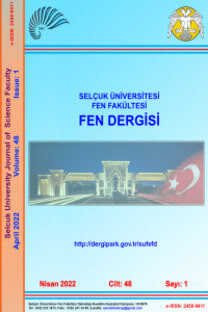1, 4-benzokinin, 2-metil-1,4- benzokinin ve tetrametil-1,4- benzokinin moleküllerinin moleküler elektronik spektroskopi yöntemiyle incelenmesi
Investigation of 1,4-benzoquinone, 2-methyl-1,4-benzoquinone and tetramethyl-1,4-benzoquinone molecules by the method of molecular electronic spectroscopy
___
[1] Silverstein, R.M., Bassler, G.C., and Morrill, T.C. Spectrometric Identification of Organic Compounds, 5nd. Ed., Wiley, New York, 1991.[2] Banwell, C.N. Fundamentals of Molecular Spectroscopy, 5nd. Ed., McGraw-Hill, London, 1997.
[3] Erdik, E. Organik Kimyada Spektroskopik Yöntemler, Ankara, 1993.
[4] Gündüz, T. İnstrumental Analiz, 3.Baskı, Ankara, 1993.
[5] Cebe, M. Atom ve Molekül Kimyası, Uludağ Ünv., Bursa, 1998.
[6] Çakır, B. Fenol, p-Bromfenol ve p-Nitrofenol Moleküllerinin Moleküler Elektronik Spektroskopi Yöntemiyle İncelenmesi, S.Ü.Fen Edebiyat Fakültesi, Fen Dergisi Konya, 18:71-80, 2001.
[7] Musheer, A.and Zahid, H.K. Electronic Absorption Spectra of Benzoquinone and its Hydroxy Substituents and Effect of Solvents on their Spectra, Spectrochim. Acta(Great Britain) A56, 965-981, 2000.
[8] Johannes, W., Karsten M. and George, H. Excited Electronic States of p-benzoquinone, Institute of Physical Chemistry, Köln, Germany, 2000.
[9] Stern, E.S., and Timmos, T.C.J. Electronic Absorption Spectroscopy in Organic Chemistry, St.Martin's Press, New York, 1971.
[10] Mrinalini, P., Jayaraman C. and Siva, U. Structure of Triplet Excited State of Tetrabromo-pbenzoquinone from Time-Resolved Resonance Raman Spectra and ab İnitio Calculations, Department of Organic Chemistry, Institute of Science, Banglore, İndia, 2000.
[11] Karabıyık,M. 1,4-Benzoquinone , 2-Methyl-1,4-Benzoquinone ve Tetramethyl-1,4- benzoquinone Moleküllerinin Moleküler Elektronik Spektroskopi Yöntemiyle İncelenmesi, S.Ü. Fen-Bilimleri Enst., 2002.
[12] Hamish, S.S., Karianne C.H., Nicholas J.T. and Russel, R. Isobenzofurans and Orthobenzoquinone Monoketals in Syntheses of Xestoquinone and its 9- and 10-Methoxy Derivatives, Department of Chemistry, Univ. of Waterloo, Ontario, Canada, 2000.
- ISSN: 1300-4905
- Yayın Aralığı: 1
- Başlangıç: 2018
- Yayıncı: -
Bekir ÇAKIR, ERHAN AKIN, YUSUF YAKAR, Mevlüt KARABIYIK, Atilla GÜLEÇ, Hüseyin YÜKSEL
N-(benzil) aminoglioksim' in sentezi ve çöktürücü reaktif olarak kullanılması
Semahat KÜÇÜKKOLBAŞI, Tevfik BİGAT
Emine ARSLAN, Leyla AÇIK, Uçkun Sait UÇAN, Ayten ÇELEBİ
Karyotype of Pipistrellus kuhlii (Kuhl, 1819) in Turkey (Mammalia: Chiroptera)
BUĞRA SARAÇOĞLU, MEHMET FEDAİ KAYA
Fibronilin soğan (Allium cepa L.) kök ucu hücrelerine sitogenetik etkileri
